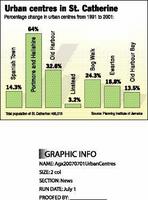

McDonald (right)Gareth Manning, Sunday Gleaner Reporter
Weak and outdated developmental plans are among the major de-ficiencies urban planners are blaming for the strain upon the main urban centres in the country. They argue that over the years, successive governments lacked the political will to drive the process of planning in the country, leaving Kingston, sections of St. Catherine and even Montego Bay unable to manage the strain of haphazard urban development, resulting in the rise of numerous informal settlements around these hubs.
The Kingston and St. Andrew metropolis and areas such as Portmore, Bog Walk, Spanish Town, Ewarton and Old Harbour in St. Catherine have been under pressure from an increasing migratory population, planners and parish officials admit. But, it appears the growing urban hubs in St. Catherine have been feeling the pinch, most of them exceeding their ability to offer basic social services to their fast-growing population.
Heavy migration
This has been due largely to heavy migration from Kingston and Clarendon to St. Catherine in the last 30 years. A lack of adequate housing in Kingston and St. Andrew has made St. Catherine, particularly Portmore and Old Harbour, the preferred place in which to reside for most people working in the Capital City. But their capacity to offer services and amenities is facing immense demands from the growing population.
According to the Planning Institute of Jamaica (PIOJ), St. Catherine has had three times the growth observed for all Jamaica, with a growth rate of 26.3 per cent in the last 10 years. It is now the parish with the largest population, standing at over 489,000 persons.
Consultant urban and regional planner, Dr. Pauline McHardy, argues that the pressure being experienced in St. Catherine has been as a result of failure to place emphasis upon urban planning. She argues that often, the emphasis has been limited to master and zoning plans that pay very little attention to the spin-offs of urbanisation, including poverty. She says that socio-economic projects need to be harmonised with land use and physical infrastructure plans.
Little significance
"Very little significance or recognition is given to urban planning because it often doesn't have this kind of economic projection - this kind of budgeting that is required to give the importance and the direction that a lot of people in other ministries would require, or even what the Planning Institute requires for their future projections and plans," she states.
Her perspective is supported by former executive director of the Natural Resources Conservation Authority, Franklin McDonald, and consultant urban planner, Allison Kenning Massa. According to McDonald, urban planning has been virtually non-existent due to the poor capacity of central government. There are not enough planners, he says, leaving several councils without the capacity to plan for expansion.
While there have been recom-mendations in past discussions on local-government reform to deal with issues such as this, none have been adopted he says. "There was a policy paper prepared ... and many of the goals and objectives of that 1993 policy paper still remain to be realised," he says.
On top of that, McDonald states that development plans for most parishes have either been outdated, are inadequate or have not been implemented. He says while the PIOJ has now developed a 25-year plan to address some of the issues resulting from the urban sprawl, it comes after several years of failure to plan and implement.
"What we have is a planning system that needs to be made to work. It is very clear that many of the plans that are on the books are outdated ... We also need to go beyond the planning documents and make planning something that people are seeing in action."
Massa agrees. She claims that the system has been marred by a lack of political will to reform a process of planning that has been fossilised in old English town-and-country planning conventions. "There are phrases in there (development orders), there are policies in there that are taken directly from old English planning documents," she argues. On top of that, she says, there are very few development plans for most parishes.
Ignorant
She says what is needed is participatory planning, which includes all government agencies and people, but there seems to be very little government interest in this aspect. "This administration does not want a joined-up government that is required to achieve that kind of rational holistic, regional planning. It is to their advantage to keep people ignorant, uninformed, unable to make decisions ... the equivalent of barefoot and pregnant," she says.
While also batting for a joined-up governance to deal with urban planning, McDonald is also arguing that a national settlement strategy needs to be developed to deal with the rapidly growing population. This strategy, he says, might include putting a cap on the population of some areas in order to properly manage expansion. "It would essentially lay down the parameters for carrying capacity. You would know what size you want, where; you know where the water supply is, and you could match demand and supply," he says.
This settlement strategy, he says, should be harmonised with national development and energy policies to create efficiency within urban centres by minimising the energy used up in the movement of people between urban centres in an effort to access services.
"The challenge is to restore a planning process which harmonises the social, the economic and the physical planning, " says McDonald.
gareth.manning@gleanerjm.com

